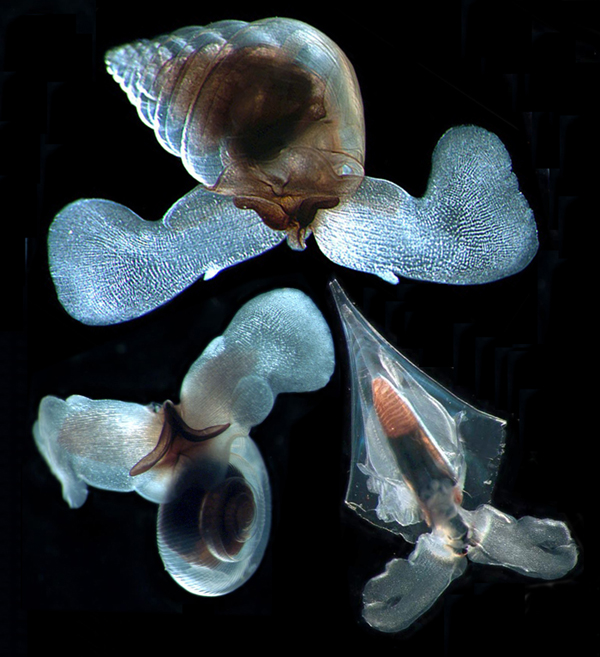Too much carbon in our atmosphere has a serious impact on life in our oceans. That alone, quite part from global warming, justifies strong action to cut emissions [10 May 2011 | Peter Boyer]
It’s un-Australian not to enjoy a bit of fizz in our beverage of choice. The bubbles that emerge from our beer, wine or soda water add sparkle to any occasion. The colder the drink the more it fizzes, which is as we like it.

Three species of pteropods, a small oceanic animal which will be seriously affected by rising ocean acidity. PHOTOGRAPHY RUSS HOPCROFT
The bubbles — carbon dioxide finding its way into the air after being held under pressure in the bottled liquid — aren’t the only cause of the fizzy sensation. Accompanying them is a slight acid taste. That’s carbonic acid, present in tiny quantities whenever carbon dioxide is dissolved in water.
But what we think is a blessing may not be so welcome for others. In fact, carbonated liquid is posing a threat to the future of some pretty crucial species in the global ocean — and it’s a direct result of today’s high levels of carbon dioxide in the atmosphere.
In interacting with the atmosphere, the waters of our oceans — especially the cold, stormy Southern Ocean — absorb carbon dioxide, which starts a string of chemical reactions that result in a slightly more acidic ocean. Just like your fizzy drink.
The most common measure of acidity of a liquid is the pH scale from 14 down to 0, with acidity increasing the closer you get to zero. Pure water is at the half-way mark on the scale with a pH of 7.0, and normal sea water is somewhat less acid at a pH of about 8.2.
Since the beginning of the industrial age about 250 years ago, the ocean’s pH has decreased from its normal level (8.2) to about 8.1. It seems nothing to be concerned about.
But consider this: marine life is used to a very narrow band of variation, such that any shift from the long-term average is no trifle. And like the Richter earthquake scale, the pH scale is logarithmic, which means that a descent from 8.2 to 8.1 means an increase in acidity of nearly 30 per cent.
Current studies have found a significant rise in recent decades in the rate at which atmospheric carbon is taken up by ocean waters, at the top end of predictions by the Intergovernmental Panel on Climate Change in 2001.
At this rate we’re looking at a doubling or trebling of the oceans’ acidity by 2100. Life has found ways of coping with past changes in ocean chemistry, but never in the past 300 million years has a shift happened as quickly as it’s happening today. That’s going to present real challenges for many species.
Australian ocean research is now centred on Hobart, home to four major marine research bodies: the CSIRO’s Marine and Atmospheric Sciences division, the Australian Antarctic Division, and the University of Tasmania-based Institute of Marine and Antarctic Studies and the Antarctic Climate and Ecosystems Cooperative Research Centre (ACE CRC).
Between them they are investigating the chemistry of the ocean — how it has changed in recent decades — and the impact of increasing acidity on multiple plant and animal species, from deep-sea corals and the ubiquitous Southern Ocean krill down to microscopic plants and animals.
The biggest concern among marine biologists is that a more acidic ocean will inhibit the formation of calcium carbonate shells and skeletons, especially those species which make their shells from a particular form of calcium carbonate called aragonite.
As Dr Donna Roberts, who’s in charge of the ACE CRC’s Ocean Acidification Project, points out, finding out how acidification will affect different species and ecosystems is no simple matter.
Science is getting a handle on which species will be most adversely affected, but it’s currently based on observing how living laboratory specimens react to changes in the pH of their tank water.
“This is a guide, but the evidence would be much stronger with good data from animals and plants in the oceans. We need many years of field work, collecting and observing live specimens out there on the Southern Ocean, before we can be sure about the impact of acidification,” says Roberts.
As in all science there’s a lot of uncertainty about how the ocean acidification story will play out, but this shouldn’t be over-emphasised. From what we presently know about ocean chemistry, the marine food web and our own reliance on the sea as a source of protein, we can already say this is at least as big a problem as atmospheric warming.
Take the case of pteropods, pea-sized animals found in great abundance throughout the world’s oceans — hundreds to thousands per cubic metre of sea water — and a major source of food for fish, birds, seals and whales.
Many pteropod species make shells from calcium carbonate, but their ability to do so will be seriously compromised by rising acidity. Losing these species would be losing not just a food source, but also a big long-term repository for all that surplus carbon sloshing around in the oceans.
We know that our oceans are acidifying, and that this is happening entirely independently of any greenhouse-induced temperature changes. What they have in common is all that extra carbon dioxide we’re belching into the air. Different problem, same solution.
